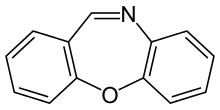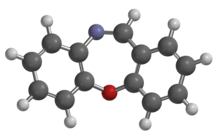CR gas
CR gas or dibenzoxazepine (also referred to as DBO), or its chemical name dibenz[b,f][1,4]oxazepine, is an incapacitating agent and a lachrymatory agent. CR was developed by the British Ministry of Defence as a riot control agent in the late 1950s and early 1960s. A report from the Porton Down laboratories described exposure as "like being thrown blindfolded into a bed of stinging nettles", and it earned the nickname "firegas".[1][2]
 | |
 | |
| Names | |
|---|---|
| IUPAC name
Dibenzo[b,f][1,4]oxazepine | |
| Identifiers | |
3D model (JSmol) |
|
| ChEMBL | |
| ChemSpider | |
| ECHA InfoCard | 100.114.990 |
PubChem CID |
|
| UNII | |
CompTox Dashboard (EPA) |
|
| |
| |
| Properties | |
| C13H9NO | |
| Molar mass | 195.22 g/mol |
| Density | 1.160±0.10 g/cm3 |
| Melting point | 73 °C (163 °F; 346 K) |
Except where otherwise noted, data are given for materials in their standard state (at 25 °C [77 °F], 100 kPa). | |
| Infobox references | |
Physical properties and deployment
CR is a pale yellow crystalline solid with a pepper-like odor. It is slightly soluble in water and does not degrade in it. CR is usually presented as a microparticulate solid, in the form of suspension in a propylene glycol-based liquid. Contrary to its common name, it is not a gas but a solid at room temperature.
The dibenz[b,f][1,4]oxazepine moiety is present in the typical antipsychotic drug loxapine, but, unlike CR, loxapine is not reactive and is not an irritant. CR was first synthesised in 1962.[3]
CR can be delivered either as an aerosol or a solution in water, making it able to be used in water cannons, smoke grenades, or handheld spray cans. For smoke it is usually fired in canisters (LACR) that heat up, producing an aerosol cloud at a steady rate.
Effects
CR gas is a lachrymatory agent (LA), exerting its effects through activation of the TRPA1 channel.[4][5]Its effects are approximately 6 to 10 times more powerful than those of CS gas. CR causes intense skin irritation, in particular around moist areas; blepharospasm, causing temporary blindness; and coughing, gasping for breath, and panic. It is capable of causing immediate incapacitation. It is a suspected carcinogen. It is toxic, but less so than CS gas, by ingestion and exposure. However, it can be lethal in large quantities. In a poorly ventilated space, an individual may inhale a lethal dose within minutes. Death is caused by asphyxiation and pulmonary edema.
The effect of CR is long-term and persistent. CR can persist on surfaces, especially porous ones, for up to 60 days.
Treatment
While CS can be decontaminated with a large amount of water, use of water may exacerbate the effects of CR. Skin contaminated with CR gas may become extremely painful in contact with water for up to 48 hours after contamination.[3]
Medical treatment is mostly palliative. The contaminated clothing has to be removed. The eyes and skin can be washed, the eye pain can be alleviated with medications.[6]
Use
Northern Ireland
It started being available in police and army supplies, as a water cannon additive and as spray cans, in 1973 and was at least still so in 1981.[1][2]
Republican groups in Northern Ireland have alleged that British Army and Royal Ulster Constabulary units used CR gas against Republican prisoners in the 1970s.[7] Additionally, there are British military documents now declassified and in the public domain held in the records of the UK Ministry of Defence at the National Archives, London, that suggest that the British Army did deploy and use CR gas in Northern Ireland. [8] [9] [10] [11] [12]
Egypt
During the 2011 protests against the military government in Egypt, Egyptian security forces allegedly used CR gas in addition to the more commonly used, less debilitating CS gas. One protester described the gas as making him feel "as if your eyes are about to fall out; then you have trouble breathing, and you lose your sight". Egyptians used yeast as a treatment for CR side effects on skin. Mohammed ElBaradei also confirmed via Twitter that "tear gas with [a] nerve agent" is being used in Tahrir Square.[13]
The only gas that has been identified by human rights organizations in protests "is CS tear gas, typically used by police forces to disperse crowds," stated Egyptian journalist Farida Helmy.[14] Egyptian use of CR gas has not been corroborated according to Human Rights Watch (HRW).
Philippines
CR tear gas was used in suppression of the mutiny in Makati that was led by Sen. Antonio Trillanes. The tear gas was fired in the building and all the people in the building including reporters were affected.
Sri Lanka
The LTTE, also known as Tamil Tigers of Sri Lanka, an insurgent group in Sri Lanka used CR gas against government forces that were on an offensive to flush and defeat these insurgents during September 2008. Its use hindered the army's progress but ultimately proved ineffective in preventing the army from overrunning LTTE positions. This is one of the first few cases of insurgents using CR gas as an insurgent weapon.
Turkey
In the June 2013 protest against the Turkish government, Turkish police allegedly used CR gas on protesters in Istanbul. Doctors in a makeshift first aid post in a Mosque judged it as such.[15][16]
Ukraine
In Ukraine, CR gas is commonly used by special forces against demonstrators. Gas is packed in a form of spray cans "Cobra 1". For example, gas has been used on demonstration dedicated to Ukraine Independence Day (Aug 24 2011).[17] Also massive gas usage has been documented during demonstrations against Language Law Draft at Kiev on Jul 3-4 2012.[18]
Vietnam
It has been reported that thousands of tons of CR gas were used by the U.S. forces in Vietnam to bring Viet Cong into the open. It was also used by the North Vietnamese forces in some battles like Hue in 1968 or during the Easter Offensive in 1972.
France
People occupying an area in Notre-Dame-des-Landes against an airport project suspect the use of CR gas by French Police and Army in April 2018.[19]
Elsewhere
In the late 1980s, CR was used in the townships in South Africa. It caused some fatalities, in particular among children.[20][21]
See also
References
- Rosenhead, Jonathon (23 Jul 1981). "The technology of riot control". New Scientist.
- Wright, Steve (6 January 1998). "AN APPRAISAL OF TECHNOLOGIES OF POLITICAL CONTROL". The STOA Programme, Directorate General for Research, European Parliament. Retrieved 3 October 2015 – via pitt.edu.
- Higginbo R, Suschitzky H (1962). "Synthesis of Heterocyclic Compounds. 2. Cyclisation of O-Nitrophenyl Oxygen Ethers". J. Chem. Soc.: 2367–2370. doi:10.1039/jr9620002367.
- Gijsen HJ, Berthelot D, Zaja M, Brône B, Geuens I, Mercken M (October 2010). "Analogues of Morphanthridine and the Tear Gas Dibenz[b,f][1,4]oxazepine (CR) as Extremely Potent Activators of the Human Transient Receptor Potential Ankyrin 1 (TRPA1) Channel". J Med Chem. 53 (19): 7011–7020. doi:10.1021/jm100477n. PMID 20806939.
- Bessac BF, Sivula M, von Hehn CA, Caceres AI, Escalera J, Jordt SE (April 2009). "Transient receptor potential ankyrin 1 antagonists block the noxious effects of toxic industrial isocyanates and tear gases". FASEB J. 23 (4): 1102–1114. doi:10.1096/fj.08-117812. PMC 2660642. PMID 19036859.
- "Tear Gases: CR - Dibenzoxazepine". Zarc International, Inc. Archived from the original on December 21, 2007. Retrieved November 22, 2011.
- inac.org Archived May 16, 2008, at the Wayback Machine
- TNA DEFE 13/1379 "Northern Ireland: use of tear gases; use of CR gas for riot control in Northern Ireland, especially at HM Prison Maze; use of SPAD (Self Protection Aid Device) as a means of delivery. 1973."
- TNA DEFE 24/967 "Northern Ireland: dibenzoxazepine (CR) gas; chemical agent for use in riot control. 1974-77."
- TNA DEFE 24/1090 "Northern Ireland: use of CS and CR gas in countering riots. 1969-77."
- TNA DEFE 24/1203 "Northern Ireland: terrorism; Operation PAGODA; use of CR gas (dibenzoxazepine). 1973-77." This document is still classified, although a record of it is listed in the National Archives (TNA) catalogue.
- TNA DEFE 24/1903 "Development of CR gas: introduction of Self Protection Aid Devices (SPAD) in Northern Ireland; includes arguments for and against their use. 1971-73."
- "Beskylder egyptiske styrker for massakre" (in Norwegian). NRK.no. Retrieved November 22, 2011.
- Farida Helmy, "Chemical Combat", Egypt Today Magazine, January 2012 issue
- 2013-06-05. "Erdogan's Police May Be Using Chemical CR Gas on Protesters". The Jewish Press. Retrieved 2013-09-02.CS1 maint: numeric names: authors list (link)
- ahmet hasan (3 June 2013). "Dolmabahçe Camii 03.06.2013 00:20" – via YouTube.
- "Керівництву МВС показали, якими "засобами гігієни" воно озброює "Беркут" - Новини - Український тиждень, Тиждень.ua".
- ""Беркут" відступив від Українського дому".
- "Zad de Notre-Dame-des-Landes : ce lundi, les gendarmes ont démoli la charpente du Gourbi". Reporterre, le quotidien de l 'écologie (in French). Retrieved 2018-04-16.
- Olajos EJ, Salem H (2001). "Riot Control Agents: Pharmacology, Toxicology, Biochemistry and Chemistry". J Appl Toxicol. 21 (5): 355–391. doi:10.1002/jat.767. PMID 11746179.
- "Ireland, Organise! Press Release -Less Lethal Weapons Action Belfast". A-Infos. Retrieved November 22, 2011.